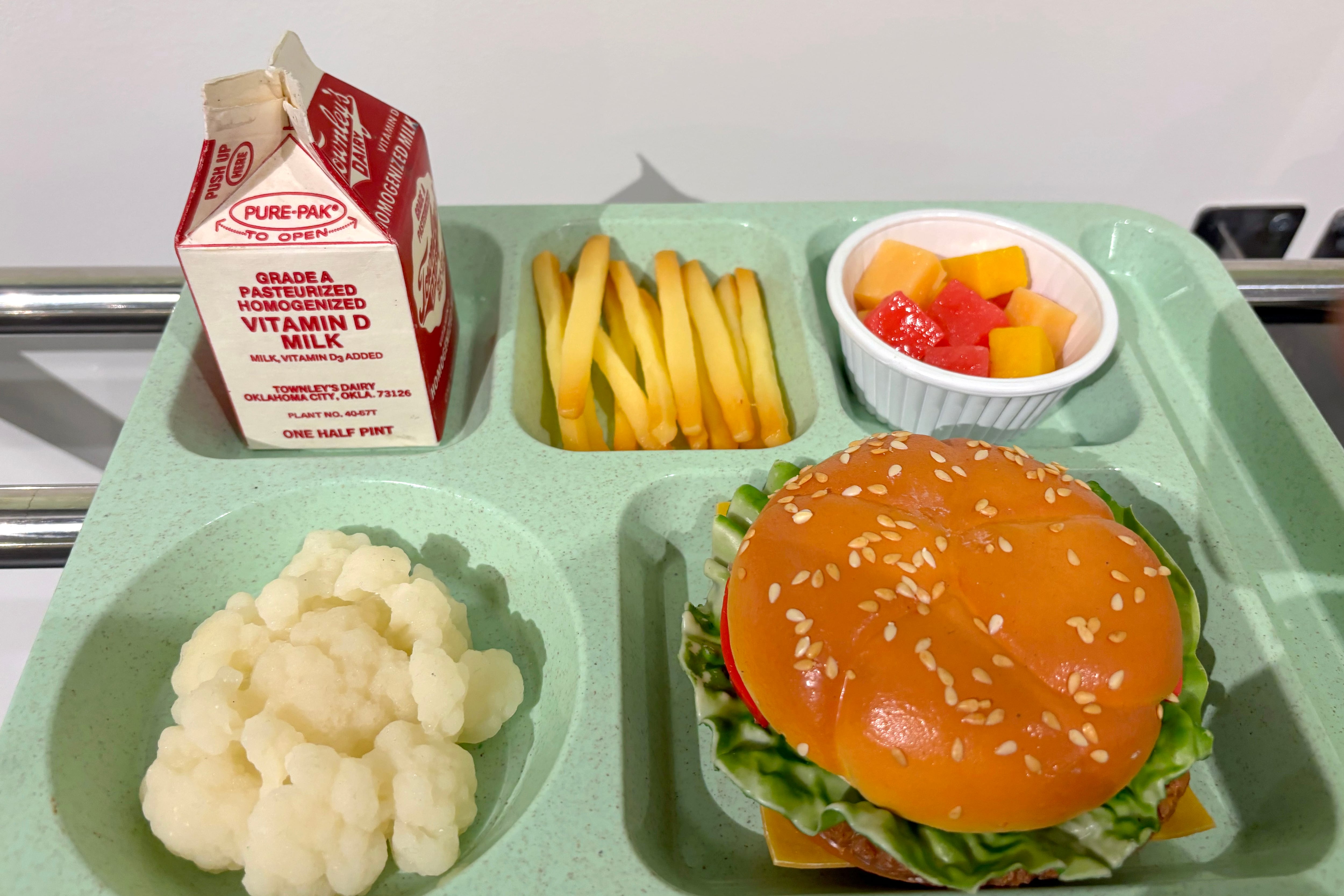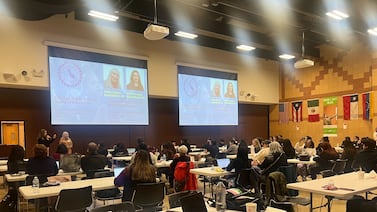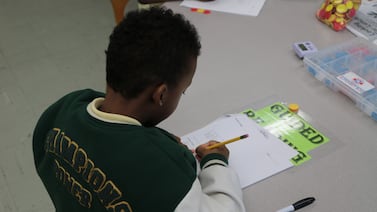Sign up for Chalkbeat Philadelphia’s free newsletter to keep up with the city’s public school system.
Pizza. Square pizza. Mac and cheese. Mac and cheese and pretzels. Cheese breadsticks with marinara. Triple decker PB&J sandwiches — with a hidden slice of whole wheat bread in the middle.
These were some of the answers posted Friday night on a board at the Science History Institute in answer to the question: “What was your favorite school lunch?”
The interactive exercise is part of the new exhibit at the museum called “Lunchtime: The History of Science on the School Lunch Tray.” Eating lunch at school is something that just about every person in the country has experience with, but rarely thinks about as a source of insight about America’s development.
The exhibit about how school lunch developed as a staple of American life says much about the U.S. and its attitudes towards compulsory education, society, poverty, nutrition, and children. It demonstrates how Philadelphia was key to the history of school lunch, and the crucial role of pioneering women scientists in promoting a healthier America through “home economics.”
The extent to which students can access free school meals could be on the ballot this year. Democrats will likely seek ways to expand it, while Republicans will probably search for cutbacks.
Minnesota Gov. Tim Walz, the Democratic vice presidential candidate, has touted the expansion of school meals while he’s been governor. Meanwhile, the Heritage Foundation’s Project 2025, which is expected to guide former President Donald Trump’s second term if he wins, proposes shrinking federal nutrition programs.
“The history of school lunch is the history of women in science and women in the labor movement,” said Jesse Smith, the museum’s director of curatorial affairs and creative content, during a talk to about 200 attendees at the exhibit’s opening reception.
The number of states that offer free school meals to all students has grown in recent years. Nine states did so as of last year.
The museum highlights Sarah Rorer, the daughter of a chemist but who was self-taught in chemistry and physiology. Rorer was a driving force behind the late 19th century push for compulsory education, arguing that schools kept students “from the harms of factory work,” and protected them “from the real dangers children faced in a rapidly urbanizing and industrializing United States.”
While “home economics” eventually got a reputation as being a vocational course in schools primarily for female students, it was actually a crucial movement started by women trailblazers in the late 19th and early 20th century that set the foundation for many advances, including the development of nutritional guidelines.
“Philadelphia was always a pioneer in school lunch programs,” said Teresa Fleming, the school district’s interim chief operating officer.
In 1894, Philadelphia was among the first cities to offer meals to students thanks to visionary women like Emma Smedley, who led the city, and the nation, in professionalizing the school kitchen.
Trained in home economics, Smedley wrote a book in 1920 as a guide for other cities about Philadelphia’s efforts. “The person in charge should have business training and acumen,” she wrote, “as well as scientific knowledge of foods and should be endowed with social vision, understanding both the business and broad educational aspects of the work.”
By 1920, 300 lunch employees served food to 50,000 children each day in 46 of Philadelphia’s 213 public schools.
Other women, like Ellen Richards, focused on the fledgling science of nutrition. To counter the then-popular notion of eugenics, which said selective breeding would improve the human race, Richards instead promoted “euthenics,” studying how habits around food and eating would lead to human advancement.
The National School Lunch Program was established by the federal government in 1946 to offer free or reduced-price lunches to students who qualified based on income. But there was often a stigma to accepting free lunch, and many students would skip it rather than signal to their classmates that they qualified based on their families’ income.
“People take school lunch for granted,” said Nada Mays, a dietitian. “And there is a little bit of a taboo toward school lunch.” Over the years, people have been critical of the actual nutrition the lunches provide, and students have been known to call them “gross.”
Such views, she said, are “extremely problematic for those children who might have food insecurity and don’t have other options but are still embarrassed to eat lunch in school.”
The U.S. Department of Agriculture’s Federal School Lunch Program sets nutritional guidelines and it is paid for by a combination of federal, state, and local funds. But sometimes funding and guidelines get caught up in politics.
In the 1980s, for instance, President Ronald Reagan’s administration famously suggested that to save money the government could classify pickle relish as a vegetable — although the incident is commonly remembered as involving ketchup.
Meera Siddharth, a pediatrician at the Children’s Hospital of Philadelphia, said funding is not the only issue. While schools work hard to follow the USDA guidelines, sometimes just scheduling lunch can be an issue, with some students having lunch periods at 10 a.m. or earlier.
“Sometimes kids skip lunch, or the school lets them go out, so they don’t always get a healthy lunch at school,“ she said.
In part to counteract this, a group of students has set up Rebel Ventures, a West Philadelphia nonprofit working with the Netter Center at the University of Pennsylvania that created a healthy multi-grain fruit breakfast cake called the Rebel Crumble.
“That is a good thing, making something that is palatable to their peers,” she said. “A lot of kids are food insecure in Philadelphia, there are food deserts, and it’s hard not to buy processed foods.”
In 2014, Philadelphia started offering free lunch to all students. In addition to negating the stigma associated with those meals, officials determined it was cheaper to do this than to process the paperwork from the more limited program.
Today, all Philadelphia students can get free lunch and breakfast in school. Feeding those 116,000 students “is a monumental task” that 925 food service workers “undertake every day,” Smedley said.
Rhyan Fernandes, an eighth grader at Southwest Leadership Academy, said that her school serves “chicken and rice and beans and peas and sloppy Joes and all that type stuff.” While her schoolmates like it, she said, “I never get in that line. I don’t know. I’m picky.”
If she could redesign her school menu, she said she’d like better cheesesteaks (the ones they already serve are not up to her standards) and more variety for breakfast like eggs, bacon, and grits. “I would love that,” she said.
The exhibit runs through January.
Dale Mezzacappa is a senior writer for Chalkbeat Philadelphia, where she covers K-12 schools and early childhood education in Philadelphia. Contact Dale at dmezzacappa@chalkbeat.org.
Bureau Chief Carly Sitrin contributed to this story.







